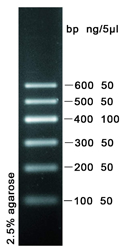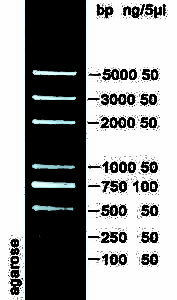-

- Home
- Shop
- Article
- About Us
- Contact Us
- Molecular Biology
- How to choose the right antibody
- Aflatoxin
- Vitamin K2
- Melatonin
- Introduction of ELISA Kits
- Food Safety Detection
- Food Safety
- Animal Disease
- Diagnosis
- Human ELISA
- Mouse ELISA
- Sheep ELISA
- Other ELISA
- Primary Antibody
- Second Antibodies
- Labeled Primary Antibody
- Labeled Secondary Antibody
- Small Molecular Antibody and Antigen
- Animal Disease Antibody and Antigen
- ELISA Test
- Rapid Test
- Diagnosis Antigen and Antibody
- Diagnosis Kit
Description
This kit uses a silicon matrix material that efficiently and specifically binds DNA and a unique buffer system to recover DNA fragments from TAE or TBE agarose gels while removing proteins, other organic compounds, inorganic salt ions and oligonucleosides. Impurities such as acid primers. Fragments of 100bp–40kb in size can be recovered with a recovery of greater than 80% (30-50% recovery of DNA fragments <100bp and >10kb). The maximum amount of DNA that can be adsorbed per column is approximately 20 μg at a time. The DNA recovered using this kit can be used in a variety of routine operations, including digestion, PCR, sequencing, library screening, ligation and transformation experiments.
Specification:100T
Storage Conditions:The kit can be stored for 12 months at room temperature (15–25℃) and at 2–8℃ for longer periods of time. (Note: When storing at low temperature, the solution in the kit should be allowed to stand at room temperature for a period of time before use. If necessary, preheat in a 37℃ water bath for 10-20 minutes to balance the solution temperature.)
Precautions:
- It is best to use fresh electrophoresis buffer when electrophoresis, so as not to affect the electrophoresis and recovery effect; if possible, try to use TAE system, because some research indicates that after using TBE system, the trace amount of boric acid in the recovered product will affect the subsequent Digestion reaction.
- When cutting the glue, the UV irradiation time should be as short as possible to avoid damage to the DNA; please try to remove the agarose gel without the target fragment, which will be helpful for the melt.
- Before the first use, please add anhydrous ethanol to the rinse liquid PW according to the label instructions, and mark it. After use, tighten the bottle cap.
Procedure: Unless otherwise indicated, all centrifugation steps were performed using a bench top centrifuge at room temperature.
- Cut a single DNA strand of interest from the agarose gel (too much of the excess) and place it in a clean centrifuge tube and weigh the weight.
- Add 3 volumes of sol PN to the rubber block (if the gel weight is 100mg, the volume can be regarded as 100ml, then add 300ml of sol solution), and place it in a 55℃water bath for 10minutes, during which the tube is gently turned upside down. To ensure that the rubber block is fully dissolved.
note:
①If the sol solution turns pink at this time, add a small amount of 3M NaAc pH 5.2 (generally, 10μl of athlete's foot), turn the sol solution into yellow and centrifuge on the column.
②For high concentration gels (>2%), the sol PN was added in a ratio of 100μl of sterilized water and 600μl of sol PN to 100mg of gel.
③After the gel block is completely dissolved, it is better to lower the temperature of the glue solution to room temperature and then to the column, because the adsorption column has a weak ability to bind DNA at a higher temperature.
- When the target fragment is <500bp, if you want to improve the recovery efficiency, add 1/3 sol solution PN volume of isopropanol to the sol system (if using 300μl sol solution, add 100μl isopropanol), mix, 55℃Step 4 is carried out after 1 minute of warm bath. When the target segment is >500bp, this step is omitted and step 4 is directly performed.
- Add the solution obtained in the previous step to the adsorption column CA1 (the adsorption column is placed in the collection tube), leave it at room temperature for 2 minutes, centrifuge at 13,000 rpm for 60 seconds, drain the waste liquid from the collection tube, and re-inject the adsorption column into the collection tube. in.
note:
①The effective volume of the adsorption column CA1 is 700μl. If the volume of the sol system is greater than 700μl, the column is applied to the column to ensure that all the solution is added to the adsorption column.
②The 2100bp and 10kb fragments should be allowed to stand at room temperature for 10minutes, which will improve the recovery efficiency.
- Add 700μl of rinse liquid PW to the adsorption column (check whether anhydrous ethanol has been added before use), centrifuge at 13,000rpm for 60 seconds, drain the waste solution, and re-inject the adsorption column into the collection tube.
- Add 500μl of the rinse solution PW to the adsorption column, centrifuge at 13,000rpm for 30-60seconds, and drain the waste.
- Place the centrifugal adsorption column CA1 back into the collection tube and centrifuge at 13,000 rpm for 2 minutes to remove the rinse solution as much as possible.
Note: This step is essential! Residues in the rinse solution can affect the recovery efficiency and DNA quality, which in turn affects downstream experiments; after centrifugation, the lid of the column is opened and allowed to stand at room temperature for 2minutes, which will help to completely evaporate residual ethanol.
- Place the adsorption column in a clean centrifuge tube, and add an appropriate amount of elution buffer EB (usually not less than 30μl) to the middle of the adsorption membrane and leave it at room temperature for 2 minutes. The DNA solution was collected by centrifugation at 13,000rpm for 1minute.
note:
①The elution buffer EB can be preheated to 70℃ and then added to the adsorption membrane, which can improve the elution efficiency.
②The elution volume of the 2CA1 column should not be less than 30μl. Too small a volume will reduce the recovery efficiency.
③The pH of the eluent has a great influence on the elution efficiency. If water is used as the eluent, the pH should be within the range of 7.0-8.5. If the pH is lower than 7.0, the elution efficiency will be lowered.
- DNA product was stored at -20 ℃.




